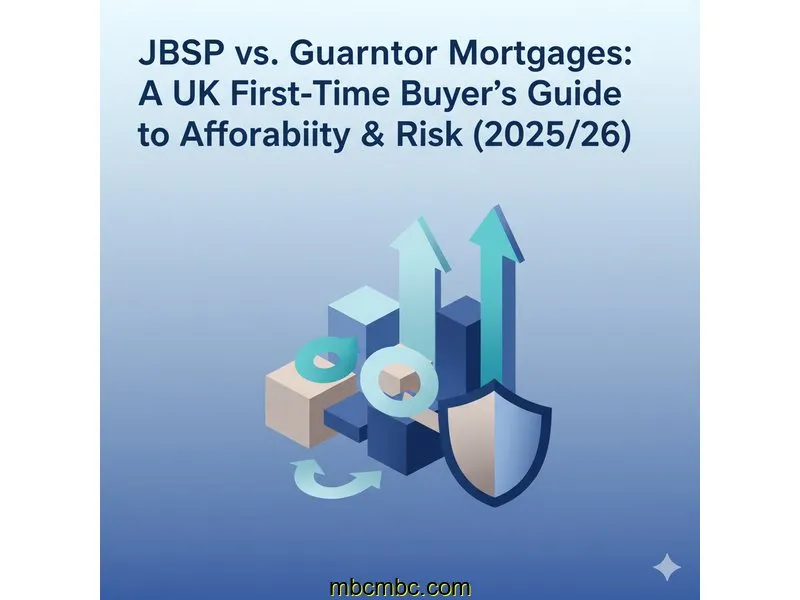
Picture this: You've meticulously saved a deposit for your first home. You've found a property, but there's a problem. With a £35,000 salary, lenders are capping your borrowing at around £157,500. The home you want is £220,000. Your parents have offered to help, not with cash, but by using their own £60,000 income to boost your application. Suddenly, your broker mentions two options: a "Guarantor Mortgage" and a "Joint Borrower, Sole Proprietor (JBSP) Mortgage."
If you're staring at those terms in confusion, you're in the right place. This is one of the most common and complex dilemmas facing first-time buyers in 2025. Both options use a third party's (usually a parent's) income to help you get a mortgage, but they work in fundamentally different ways, with vast implications for affordability, risk, and even your stamp duty bill. Getting this choice wrong can be a costly mistake for both you and your family.
Key Takeaways
- Affordability Boost: A **Joint Borrower, Sole Proprietor (JBSP)** mortgage typically offers a much larger borrowing amount, as the lender combines your income with your helper's (e.g., parents') income.
- Liability is Key: With JBSP, your helper is **'jointly and severally liable'** for the *entire* mortgage debt from day one, just like you are. With a Guarantor mortgage, the helper is only called upon if you *default* on your payments.
- The SDLT 'Hack': A primary benefit of JBSP is that it can avoid the 3% Stamp Duty Land Tax (SDLT) surcharge, even if your parents are homeowners. This is because they are on the mortgage (the loan) but not the deeds (the property ownership).
- Product Rarity: True Guarantor mortgages are now much rarer in the UK. Most major lenders have shifted to JBSP products, as it gives them greater security (Source: Broker Analysis, 2024).
- Disclaimer: This article provides informational guidance on mortgage concepts as of November 2025. It is not financial or legal advice. These are complex products with significant long-term risks. You must consult an independent mortgage broker and solicitor to analyze your specific family financial situation before proceeding.
The Core Dilemma: What Are You Asking Your Parents To Do?
Before we get into calculations, let's explore the fundamental difference. It's all about the nature of the promise your parents are making to the bank. A simple analogy helps.
Think of it this way:
- A **Guarantor Mortgage** is like your parent standing *behind* you at the bank, telling the lender, "If they miss a payment, I promise to cover it." They are a human safety net.
- A **JBSP Mortgage** is like your parent standing *beside* you at the bank, co-signing the loan agreement and saying, "We are *both* 100% responsible for this entire loan until it's paid." They are a full partner in the debt, even if they get no stake in the house.
This difference is crucial. With a JBSP, the lender doesn't have to wait for you to default. Your parent is on the hook from the moment the mortgage completes. This is why lenders prefer them—it's a much stronger guarantee. It's also why guarantor mortgages have become a niche product, while JBSPs are now common with high-street lenders.
JBSP vs. Guarantor: The Ultimate Comparison
Let's move beyond the analogy and put these two products side-by-side. The table below breaks down the practical differences for you, the first-time buyer. We'll use our scenario: you earn £35,000, your parents earn £60,000 (and own their home), and you want to buy a £220,000 property.
| Feature | Joint Borrower, Sole Proprietor (JBSP) | Guarantor Mortgage |
|---|---|---|
| Affordability Calculation | High Boost. The lender combines incomes. (e.g., £35,000 + £60,000 = £95,000). At a typical 4.5x multiplier, this could mean borrowing up to £427,500 (minus other debts). This easily covers your £220,000 target. | Low/Medium Boost. The lender assesses you first. Your £35k income is the primary source. The guarantor's income is only assessed to ensure they can cover your payment *if you default*. You may not be able to borrow much more. |
| Legal Liability | Joint and Several. You AND your parents are 100% liable for 100% of the debt. If you lose your job, the bank can pursue your parents for the *entire* monthly payment, not just your share. | Contingent. Your parents are only liable *if* you miss payments and break the terms. The specifics vary: some guarantee the whole loan, others just the 'top-up' amount. |
| Property Deeds (Ownership) | You (the "Sole Proprietor"). Your name is the only one on the property deeds. You are the sole owner. This is the "SP" in JBSP. | You. The guarantor has no claim or stake in the property. They are not on the deeds. |
| Stamp Duty (SDLT) Impact | No 3% Surcharge. This is the key benefit. Because your parents (who are homeowners) are NOT on the deeds, the 3% "second home" surcharge is **not** triggered (Source: HMRC Guidance, 2025). You just pay standard first-time buyer rates. | No 3% Surcharge. The guarantor is not on the deeds, so the surcharge is not triggered. (Note: If your parents were on a *standard joint mortgage* with you, this would trigger a massive SDLT bill). |
| Product Availability (2025/26) | Common. Offered by many high-street lenders (e.g., Barclays, Halifax, Skipton) as their main "family assist" product. | Rare. Offered by far fewer lenders, often specialist or building societies. Many lenders have withdrawn these products (Source: Broker Analysis, 2024). |
Deep Dive: The Risks and the "Exit Strategy"
The table shows why JBSP is so popular: it solves the two biggest problems for first-time buyers. It dramatically boosts affordability *and* neatly sidesteps the 3% SDLT surcharge trap. But it's not a silver bullet. The "joint and several liability" clause is a significant risk for your parents.
It means that if you were to stop paying, the lender wouldn't just ask your parents to "cover your payment." They would see your parents as the primary borrower, identical to you. They could pursue them for the full amount immediately and could even seek to repossess *their* home if they also defaulted (depending on the loan terms). This is a massive financial and emotional commitment to ask of them.
This is why having an "exit strategy" is non-negotiable.
Step-by-Step: Planning Your JBSP Exit
A JBSP mortgage should not be a 25-year arrangement. The goal is to get your parents off the mortgage as soon as you can afford the repayments on your own. Here’s the typical plan:
1. Set a 5-Year Goal: Plan to re-evaluate when your initial fixed-rate period ends (e.g., in 2, 3, or 5 years). By this time, you'll hopefully have had pay rises.
2. Calculate the Target Income: To remove your parents, you must prove to the lender that you can afford the remaining mortgage on your *sole* income. For example, if the remaining loan is £200,000, you'll need a solo income of at least £45,000-£50,000 (at a 4.5x-4.0x ratio) to pass the affordability checks.
3. Apply for a "Remortgage with Transfer of Equity": This is the legal process. You will remortgage the property in your sole name, and your parents will be legally removed from the loan agreement. This requires a solicitor and a new mortgage application.
4. Consider Your Parents' Age: Lenders have a maximum age for mortgage terms (often 70-75). If your parents are in their late 50s, a lender may only grant a 15-year term, making the monthly payments much higher. This is a critical factor in the initial calculation.
Common Questions from First-Time Buyers
Based on questions I've seen across UK personal finance forums, here are the three most common points of confusion for buyers like you.
1. How much *more* can I actually borrow with a JBSP mortgage compared to a guarantor?
Significantly more. With a guarantor, the lender is assessing your £35k salary and just wants to know your guarantor can cover the payments *if* you fail. With a JBSP, the lender combines the incomes. Most lenders cap borrowing at 4.5x the combined income (Source: Lender Criteria, 2025). In our scenario (£35k + £60k = £95k), this is a theoretical max of £427,500. This is a game-changer for affordability in expensive areas.
2. If my parents are on a JBSP mortgage, do they have any claim over my property?
Legally, no—provided it's set up correctly as "Joint Borrower, Sole Proprietor." Your name is the only one on the Title Deeds (the "proprietor" part), meaning you are the 100% legal owner. Your parents are only on the mortgage (the "joint borrower" part), which is the debt. However, a solicitor will insist your parents get independent legal advice to ensure they understand they are taking on all the liability with none of the ownership.
3. What's the 'exit strategy' for a JBSP? How do I get my parents' names off the mortgage?
The "exit" is to remortgage the property in your sole name. This is a brand new mortgage application. You must prove to the new lender that your own salary is high enough to support the entire remaining loan. You cannot simply "take their name off." It's a full affordability reassessment, which is why your income growth in the first 5 years is the most important part of the plan.
Conclusion: Your Next Steps

For most first-time buyers in 2025, the JBSP mortgage has become the default tool for family assistance. It powerfully solves the affordability and stamp duty problems in one go. The trade-off is that it places a significant, 100% liability on your parents for the entire debt—a much larger risk than a traditional guarantor arrangement.
This isn't just a financial transaction; it's a major family agreement. Your next step is not to pick a product, but to have a very open conversation with your parents about the "what ifs." What if you lose your job? What if they want to retire? What if your relationship breaks down? These are the scenarios an independent mortgage broker will—and must—discuss with you both. This guide gives you the framework, but for a decision this big, professional, personalised advice is non-negotiable.

